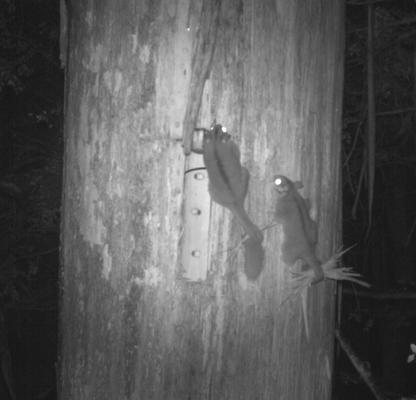
By JESSE GRAHAM
THE world’s leading expert on the Leadbeater’s Possum has said artificial tree hollows are not a “failsafe” option for the critically-endangered animal after a VicForests discovery last month.
On Friday, 27 November, VicForests announced that possums had been discovered living in or using 11 man-made tree hollows carved into trees in Warburton, Powelltown and Noojee.
The announcement came after remote sensor cameras were used to monitor the holes, and photographs from the cameras show two possums at one of the hollows.
VicForests’ general manager of planning Nathan Trushell said the study was undertaken with VicForests and the Department of Environment, Land, Water and Planning’s (DELWP) Arthur Rylah Institute (ARI).
“The possum builds a very distinctive nest using strips of bark, and remote sensor cameras have captured numerous images of possums carrying bark in their tails as they head up to the hollows to build a home,” he said.
Mr Trushell said that 72 hollows were created at 18 sites, and that 11 of these were either occupied or contained “evidence” of nests being built.
But Australia National University Professor David Lindenmayer, AO, said the hollows were necessary because of the logging body “mismanaging” the forests.
“They’re the ones that have created this shortage of natural hollows,” he said.
“So here we have an example of animals using artificial hollows, not because they want to, but because they have no other choice.”
Prof Lindenmayer said that hollows took between 100-150 years to develop in Leadbeater’s habitat trees, and that artificially creating hollows was a “band-aid” solution.
“This is like a band-aid for a major burns victim,” he said.
“This is not going to solve the problem, VicForests knows that.
“We have literally no evidence that this is going to be a failsafe strategy for the next 150 years, because that’s how long it takes to re-grow a big hollow tree.”
Mr Trushell said the trees where hollows were made were in areas where possums were recently detected, with trees younger than those used by the possum.
“This is the first step in looking at new ways to create nesting sites for the species and, while the findings don’t solve the challenges facing the possum and its preferred habitat, the initial results are fantastic,” he said.
He said the monitoring program “has only just begun”, and that the sites would continue to be monitored – along with 116 colonies detected since December last year, outlined in a recently-released report by the Victorian Government.
The artificial tree hollows were part of 13 recommendations handed down by the Leadbeater’s Possum Advisory Group (LPAG) to the previous State Government in 2014.
The future of the possum is currently being discussed by a Forest Industry Taskforce, with industry, government and environmental representatives meeting to form recommendations, which will be released mid-2016.






